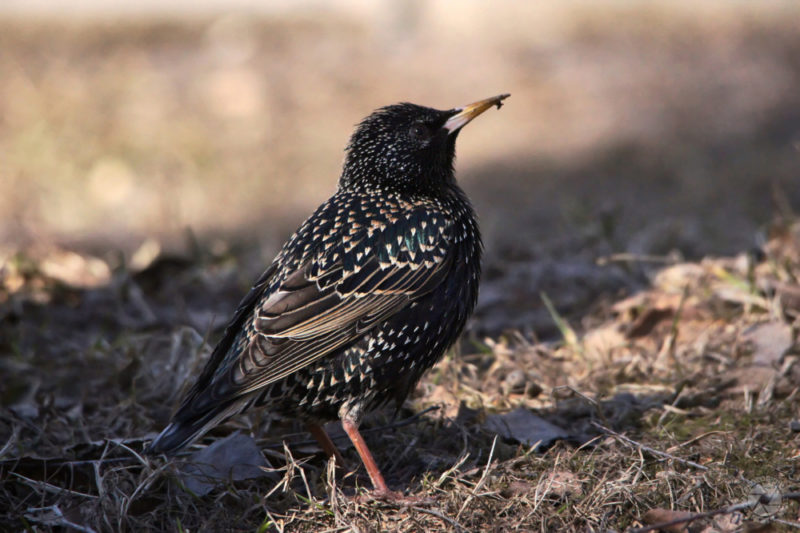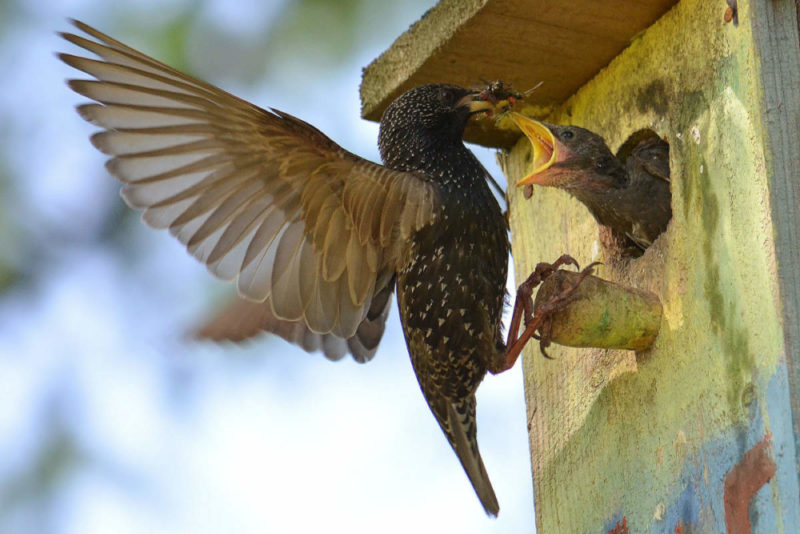An ordinary starling has interesting habits and an inquisitive character. He knows how to sing and imitate various sounds, is easily tamed and suitable for keeping even at home.
Material Content:
Description and features of an ordinary starling
The bird is a characteristic representative of the Skvortsov family of the genus of singing birds. Description of the species can begin with the starling having a bright black plumage, which slightly changes hue depending on the season. In winter and spring, many white or grayish spots appear on its feathers, which are scattered across the chest, abdomen, head and wings. After the molt occurs, the color of the pen turns black with a pronounced metallic luster, you can notice blue, green, purple and bronze overflows on it.
The size of the common starling (sturnus vulgaris) does not exceed 21-22 cm. It has a short neck and a small tail, small wings and a massive body. Beak slightly flattened, long, sharp, yellow. The iris is brown. Females have a more elegant neck than males. And the latter under the beak has a blue spot. In appearance, the bird resembles a blackbird. But starlings move on the ground, striding, and blackbirds - jumping.
Lifestyle & Habitat
Starlings are found almost everywhere, only deserts and tropics are not included in the habitat. These birds were specially introduced to North America, South-West Africa, New Zealand and Australia by humans. Migrants easily took root in new regions, often crowding out local residents. They are trusting in relation to a person, therefore they quickly master urban and rural territories. They can be found in gardens and squares, near farms and landfills.In open spaces, birds often gather in numerous flocks and write intricate pirouettes in the air.
In the wild, they can be found in the not very deaf forests of deciduous, coniferous or mixed type. Nests can be located as high on trees as in shrubs and even on the ground among the roots or grass. In cities, they willingly make nests on open balconies, in a forgotten bucket or flower pot, in architectural niches or crevices of buildings. People are almost not afraid and are easily tamed.
Starlings lead a migratory lifestyle in the cold northern regions and settled in the southern. In Belgium and Great Britain in the winter they do not leave their homes, in Germany, the Netherlands, Switzerland - they leave partially. In Russia, Northern Ukraine, Scandinavia, Eastern Poland - they leave the country completely. They winter in the North-West of Africa, in India, in the South of Europe.
Bird feed
Sturnus vulgaris is not picky about food. His diet includes a large number of insects (caterpillars, flies, butterflies, larvae, worms, beetles). In summer and autumn, the menu is also enriched with a variety of grains, berries, seeds, nuts and ripe fruits. Birds easily cope even with solid food. They peck seeds and nuts with their beaks, and then, sharply opening it, chop the food, reaching the pulp.
Based in orchards and vineyards, they can cause damage to agriculture, damaging crops. But at the same time, birds exterminate a huge number of insect pests, so most gardeners are happy to see them on their lands.
Starling breeding
Starlings are polyamorous. During the season, they can mate with several females, which during the summer make from 1 to 3 egg laying. Both parents are involved in creating the nest and caring for the chicks.
From the end of February to the beginning of March, the appearance of the first migratory birds can already be observed in the middle lane. At first males arrive. They select and occupy the places most suitable for reproduction, and announce their find by relentless singing.
A little later, the females arrive and choose a suitable batch for themselves. Courtship does not last long and after a few weeks, hatching begins. Chicks hatch after 10-14 days, and after 3 weeks they are already able to leave the nest and begin self-feeding.
Life span
In the wild, the life expectancy of birds largely depends on the conditions in which they find themselves. The environmental situation, the availability of places for the safe breeding of offspring, the quantity and quality of feed available for eating, and much more are important. In the city, the starling can live 7-8 years, in the forest or countryside - up to 12. At home, with good care and maintenance in a spacious aviary - maybe more.
Home Content
These birds are one of those that easily endure the conditions of captivity and do not lose their appetite or brisk temper locked up. The only condition is that the cell must be spacious. Starlings do not belong to clean species. They like to bathe, spraying water, they can tip the containers with food and scatter the contents of the litter. Those who want to get these birds need to be prepared for the fact that the space around the cage (floor, walls, and sometimes the ceiling) will be stained with excrement and food debris.
Note! Given the aggressiveness of these birds and their restless disposition, it is not recommended to keep them in the same enclosure with other birds of the same size and, especially, with smaller species.
Feeding Sturnus vulgaris is easy. He eats boiled and raw meat, eggs, cereals, bread, cereals, cottage cheese, insect larvae, ant eggs and much more. If you let him fly freely around the room, he can save the room from mosquitoes, flies, spiders and other unpleasant living creatures.
Starling is of great interest as a songbird. Many owners are attracted by the opportunity to teach their pet to repeat certain words or sing songs.The feathered one is endowed with the gift of imitation no less than most parrots.
Interesting fact. These birds are capable of reproducing not only fragments of human speech, but also sounds of non-natural origin: machine signals, knocking on keys, phone ringing.
Voice of a songbird
Although the singing of these winged creatures is sung in verses and songs, it may not always seem pleasant. The starling's voice consists of many sounds, this is a whistle, and a creak, and rattling, and even meowing or croaking. The chirping and clicking trills are quite loud and can be annoying in close proximity (keeping a pet in the apartment). The songs are continuous in nature and do not differ in a clearly defined duration. Mostly males sing, but females held in captivity can also show the ability to imitate sounds.
Sturnus vulgaris has long been adjacent to humans. Inhabited in gardens and farms, it brings considerable benefits. Its beautiful plumage, peppy character and vivid vocal abilities make the bird interesting for observation in the natural environment and attractive for captivity.















